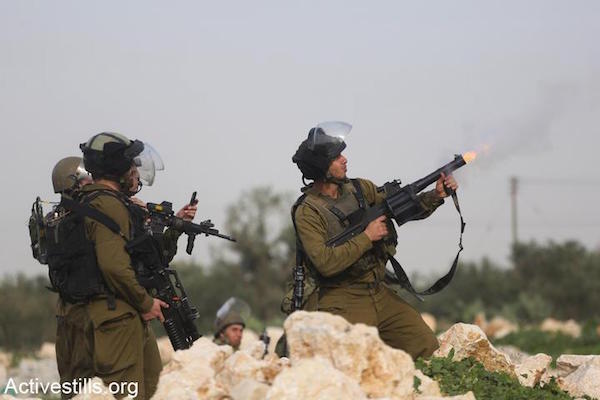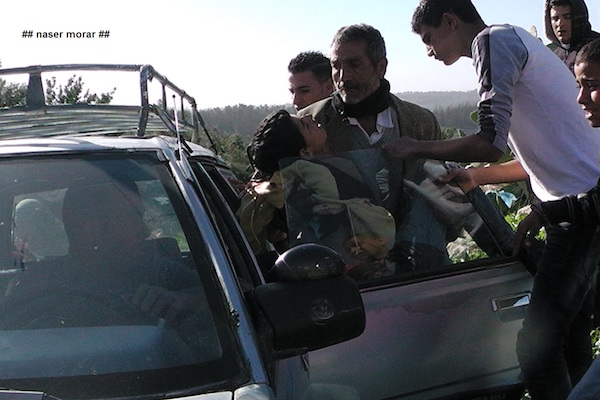The IDF Spokesperson and Israeli media outlets said that a young Palestinian man from the village of Budrus was shot while trying to snatch a soldier’s weapon. An eye witness, photographs and the autopsy tell a different story — that he was shot in the back, from some distance.
By John Brown*

Soldiers from the Israeli Border Police and the IDF’s Home Front Command shot and killed 22-year-old Yousef Awad in the West Bank village of Budrus last Friday.
“During a violent and illegal riot in the village Budrus, in which approximately 80 Palestinians threw stones and Molotov cocktails toward the security fence, a main rioter who resisted arrest was detained and even tried to grab the weapon of one of the soldiers. The troops responded by shooting him and a hit was confirmed. The incident will be investigated.” That’s how the IDF responded to the event.
Walla! News reported the IDF’s version as fact, without any real evidence to back up the claim: “A Palestinian tried to grab a weapon from a soldier and was shot to death.”
A number of findings which obtained by Local Call, +972’s Hebrew-language sister site, cast doubt on the the army’s version of the events. First and foremost, Awad was shot in the back, and likely from a distance — which seemingly contradicts the army’s claim that he attempted to snatch a soldier’s weapon.
One would think that after soldiers from the Home Front Command lied in March 2013 about an incident at Allenby Bridge — in which they claimed the exact same thing happened — and Ynet reported that a “Palestinian tried to grab the soldier’s weapon and was shot to death,” a claim that was later found to be untrue (the soldiers will likely be charged), journalists would be a bit more careful when it comes to these kinds of reports.
The fact that during that same month, soldiers of the Home Front Command were involved in the unlawful discharge of a weapon toward Palestinians and another soldier from the same unit was convicted of the involuntary manslaughter of Uday Darwish, did not cause the reporter to think twice the article.
So what happened in Budrus?
First, the Palestinian testimony. According to Iyad Awad, who was at the scene, the soldiers set up an ambush near the fence. When Yousef approached they hit him, shot a rubber bullet in his leg and grabbed him. When his friends saw what was happening, they tried to free him, he pushed one of the soldiers and managed to escape. As he ran away, one of the soldiers shot him from a distance of 10 meters — this was the shot that killed him.
According to this version, Awad was shot in his back while running away. According to the IDF’s version, if he was shot while trying to grab a weapon, then it is likely that he was shot on his front side. Photos that were given to Local Call clearly show that Awad was shot in his back; there is an entry wound in the center of his back, and an exit wound in the left side of his stomach. There difference between the wounds is stark: the entry wound is close in diameter to a 5.56 millimeter bullet, which is used by the IDF. The exit wound in Awad’s stomach is far larger, which is usually the case with such bullets. We chose not to publish the photos, although we did manage to confirm their authenticity.
The testimonies and photos are buttressed by an autopsy conducted in Qalqilya, whose results were passed on to Local Call by Israeli human rights group B’Tselem. The autopsy showed that Awad was indeed shot in the back, and that the bullet hit two aortas, a kidney and his pancreas. His feet and knees were also bruised. According to the pathologist, the findings show that Awad was shot at a range of up to 10 meters — not at point-blank range during a struggle.
The physical findings are consistent with the Palestinian version. It is possible that while Awad was being attacked he may have touched the soldier’s weapon, which means that the IDF’s version is not entirely a lie. It does not, however, explain why Awad was shot. We can assume that Awad’s back did not constitute a threat to the troops.
In addition, the soldiers’ actions are not consistent with the version according to which Awad tried to steal a weapon. They did not bother to catch him and detain him after wounding him, as one might expect had he been a terrorist. In fact the soldiers did not even know that Awad died of his wounds — they left him there. His friends and family were not interrogated as is common in such cases.
So why was Awad shot? The area of the clashes near the separation fence is constantly monitored by Israeli army cameras, and there is a high possibility that the entire incident was captured on tape. Usually the IDF releases the footage of terrorist attacks. Why don’t they do so this time?
We turned to the IDF Spokesperson with all the questions and doubts raised here. We received the exact same response to all the media outlets.
A replay of events

This isn’t the first time the IDF has refused to release footage of what ostensibly appears to be unlawful discharge of a firearm against Palestinians in Budrus. A chillingly similar thing happened two-and-a-half years ago in the exact same spot. On January 15, 2013 soldiers from Unit 71 ambushed young men from the village, who tend to throw stones at soldiers in the area near the separation fence. Some of the teens planned to go to the fence after school, but only one of them, 16-year-old Samir Awad, did so. Witnesses at the scene described what followed:
Samir Awad climbed the first fence, and found himself caught between two fences — the one he had just climbed and the separation fence, which he is not allowed to climb. The soldiers shot two warning shots in the air while as they leapt from the ambush. Awad became frightened and tried to climb back over the first fence toward the village, but at that moment the soldiers shot him in the thigh. Awad, despite being wounded, managed to cross the first fence and began running toward the village.
One of the soldiers who followed him grabbed his arm, yet Awad managed to free himself and continued to run. The soldiers caught up, and when they were about 10 meters away, two of them shot him in the nape, killing him. This description is provided by both B’Tselem, Amnesty, and Awad’s autopsy.
Following the opening of the investigation, it became clear that the soldiers’ versions were deceitful and contradictory. It was clear that the soldiers did not follow the army’s rules of engagement, which despite their lenience, do not permit shooting a teen, who does not pose any danger, in the back or the nape.
Last April, after more than two years, the state prosecutor decided to indict the soldiers for “reckless or careless use of a firearm.” This law was amended in 2005 in order to prevent gunfire at weddings, such that its use in the case of a near-execution of a teenage boy is beyond unreasonable. “A reckless act” is a crime that does not require intention while ignoring the actual killing, and in which the guilty part is not sentenced to jail time, and tends to carry a sentence of community service. In this case, one can only assume that the indictment will lead to a plea bargain, one that doesn’t include prison time or even a conviction.
This week, after another delay of half a year — due to a petition to the High Court — the state prosecutor announced that it would finally serve the indictment. According to state, the Military Police’s investigation failed to determine which of the two soldiers shot the fatal bullet, since both of them fired their weapons, yet it remains unclear which one of them shot Awad in the nape. This is an absurd argument, and becomes even more so in light of the fact that the cameras likely caught the incident on tape. The IDF, however, refuses to release the footage, perhaps to prevent criticism of a potential plea bargain.
*John Brown is the pseudonym of an Israeli academic and a blogger. This article was first published in Hebrew on Local Call, where he is a blogger. Read it here.

